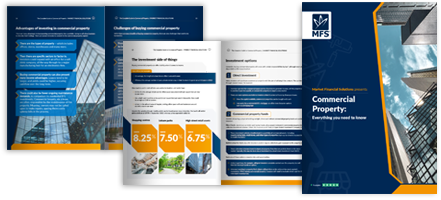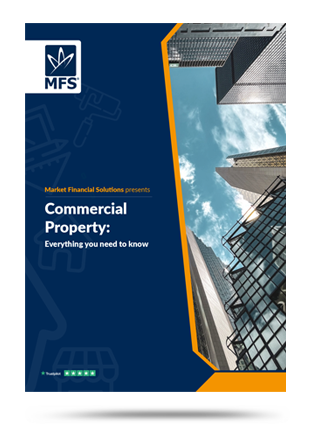Disclaimer
Market Financial Solutions are a bridging loan and buy-to-let mortgage provider, not financial advisors. Therefore, Investors are encouraged to seek professional advice. The information in this content is correct at time of writing.

Business rates can be defined as a tax on property used for business purposes. Therefore, it’s vital that landlords in the commercial property space are aware of the various local government business rates they may be subject to. In this blog, we will outline some of the things commercial landlords need to know about the taxes they may face from local authorities. As ever, investors should also seek professional tax advice.
What Are Local Government Business Rates and Which Businesses Have to Pay Them?
Local government business rates (sometimes known as commercial rates) help local councils fund the services they provide to their community. Examples include policing or waste management.
Most non-domestic properties will need to pay local government business rates. These can include offices, shops, pubs, factories, and warehouses[1]. However, holiday rentals or buy-to-let properties can also incur business rate charges.
Sometimes, business rates are charged when only a small part of the building is used for non-domestic purposes. Residential flats with pubs underneath them may fall into this category. As such, it’s important for mixed-use property owners to keep on top of what they may owe.
Similarly to council tax, business rates are paid in ten equal instalments throughout the year[2]. If a payment is missed, owners will eventually need to make bigger payments to cover the outstanding balance.
Who Pays Local Government Business Rates?
The responsibility of paying business rates falls on the occupier of the premises. As such, both landlords and tenants can be required to make the payments. Often, landlords will add the business rates to their tenants rent, passing the cost onto them.
In truth, it’s up to both the landlord and the tenant to decide who covers the payment as part of the tenancy agreement. But ultimately, it’s the occupier who is responsible. Action could be taken against a tenant, not the landlord, if a payment isn’t made.
Are Business Rates Payable on Empty Properties?
Business rates are payable on both empty and occupied premises. Although, empty property relief may be available[3]. Generally, from the moment a commercial property is left empty, no business rates are due for three months. Beyond this, most businesses will be charged local government business rates again once the three months are up.
Some types of businesses and premises can also get extended empty property relief. This includes:
- Industrial premises which are exempt for six months total
- Listed buildings – until they’re reoccupied
- Buildings with a rateable value under £2,900 – until they’re reoccupied
- Properties owned by charities – but only if the property’s next use will be mostly for charitable purposes
- Community amateur sports club buildings – but only if the next use will be mostly as a sports club
It’s worth noting that exemptions are based on the property, not the occupier. If an investor takes on an empty property that’s exceeded the exemption period, they would be expected to cover the cost of the business rates.
It’s possible that some property owners may be entitled to empty property relief, but are not receiving it. To see if that’s the case, and amend the issue, local councils should be contacted for further guidance.

Who Sets Business Rates and How Are They Calculated?
Local government business rates are based on a property’s “rateable value[4]”. The valuation process is managed by the Valuation Office Agency (VOA[5]), which is responsible for valuing 2.1 million non-domestic properties across England and Wales[6]. The valuations are used by councils to calculate local government business rates.
The rateable value can be thought of as the open market rental value (annually) a property could have been let for at a certain date. It’s calculated via three main methods:
- Rental comparison
- Receipts and expenditure
- Contractor’s basis
Local councils will work out their business rates by multiplying the rateable value of a property by a “multiplier”, and then add any applicable relief. Currently, the multiplier is 0.546[7], or 0.499 for businesses that qualify for small business rate relief.
So, for example, if a property’s rateable value was £50,000, and the applicable multiplier was 0.546, the business rate would be £27,300.
Ahead of taking on a commercial property investment, it’s possible to estimate a business rates bill via the government’s website[8].
Impact of Business Rates on Small Businesses
Put simply, business rates have become one of the most significant overheads for small businesses that own or rent a property valued at – or above – £12,000 (business rates will generally not be applied to properties valued under this £12,000 benchmark[9]).
Local authorities collect billions year after year in business rates[10]. What’s more, significant fluctuation in rental values[11] across different industries will result in some commercial property owners paying more than others.
Also, in some regions[12], business rate discounts and reliefs have been cut, costing businesses even more money. Still, it should be noted that it’s possible to appeal against rateable values, if owners believe them to be unfair or wrong[13]. Where it’s found that a person has overpaid, they may receive a refund from the VOA.
Can I Get a Discount on Local Government Business Rates?
Some properties are eligible for discounts when it comes to their local government business rates – known as “business rates relief”. These reliefs can cover a broad range of circumstances. For example, small businesses; retail, hospitality and leisure properties, charities, local newspapers, and solo businesses in rural areas may be eligible for various reliefs.
Also, owners may be eligible for relief or support if:
- They own a property and it’s empty, partly empty or being refurbished
- Their rates change by more than a certain amount at revaluation
- They’ll get less small business or rural rate relief after 1 April, 2023
- They are in financial difficulty
- Their property is in an “enterprise zone”
- The property is in a “freeport”
- Their property is a heat network
In Rachel Reeve’s 2024 budget, it was revealed that business rates relief for the UK’s hospitality and retail sectors would be extended. The Chancellor announced a 40% business rates relief for the industry, which is down from the current 75% rate set to expire on 31 March. The 40% rates relief, up to a cap of £110,000 per business, will be in place through 2026[14]. The Government also launched a paper, “Transforming Business Rates”, exploring reform options for the system[15].
How Can Market Financial Solutions Help Commercial Property Investors Navigate These Rates?
With 18 years of experience behind us, our team of experts have become our most valuable asset. Here at Market Financial Solutions, we look at the bigger picture and have the expertise to overcome potential obstacles that might arise for property investors.
For example, if one of our clients had just taken over a café or restaurant that had been vacant for three months, they might require a bridging loan that will also help them pay off the pre-existing business rate bill.
Because we consider all applications on a case-by-case basis, we would be able to recognise the property’s value as a commercial space. Therefore, by underwriting from the start of an application process, we can take on projects other lenders might shy away from.
To find out more about how Market Financial Solutions could help you with your commercial property venture, head to our website.

The Complete
Commercial Property Guide
Everything you need to know
- Extensive introduction
- Lease types
- Regulations & responsibilities
- Finance
[1] https://www.gov.uk/introduction-to-business-rates
[2]https://www.royalgreenwich.gov.uk/info/200210/business_rates/578/pay_your_business_rates#:~:text=Business%20rates%20are%20usually%20paid,the%201st%20of%20each%20month.
[3] https://www.gov.uk/apply-for-business-rate-relief/empty-property-relief
[4] https://www.gov.uk/introduction-to-business-rates/how-your-rates-are-calculated
[5] https://www.local.gov.uk/topics/finance-and-business-rates/local-taxation-council-tax-and-business-rates#:~:text=Property%20valuations%20for%20both%20council,on%20a%20five%2Dyear%20cycle.
[6] https://valuationoffice.blog.gov.uk/2024/03/04/how-we-work-with-local-authorities-business-rates/
[7] https://www.gov.uk/government/publications/12024-confirmation-of-business-rates-multipliers-and-relief-information/12024-confirmation-of-business-rates-multipliers-and-relief-information
[8] https://www.gov.uk/calculate-your-business-rates
[9] https://hackney.gov.uk/business-rates-help
[10] https://www.gov.uk/government/statistics/national-non-domestic-rates-collected-by-councils-in-england-2022-to-2023/national-non-domestic-rates-collected-by-local-authorities-in-england-2022-to-2023
[11] https://www.lsh.co.uk/explore/research-and-views/view-points/2023/july/london-occupiers-face-significant-increases-to-their-rates-bills
[12] https://www.itv.com/news/wales/2024-02-23/landlord-says-pubs-are-in-survival-mode-as-business-rate-relief-is-cut
[13] https://commonslibrary.parliament.uk/business-rates-appeals-england/
[14] https://www.cityam.com/autumn-budget-2024-reeves-extends-rates-relief-for-retail-and-hospitality/
[15] https://www.farrer.co.uk/news-and-insights/what-does-the-budget-mean-for-uk-businesses-and-business-owners/




